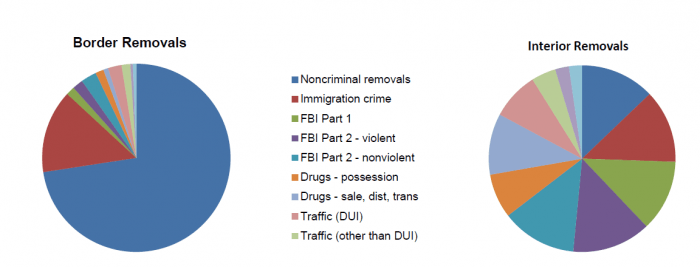MPI Report Offers Most Detailed Analysis Yet of U.S. Deportation System under DHS; Examines Criminality, Origin, Gender & More of Deportees
Men Account for 91% of All Deportees in 2003-2013; Deportations Disproportionately Target Mexicans and Central Americans
WASHINGTON — Even as deportation of criminals has risen steadily over the past decade, non-criminals represent a majority of the 3.7 million formal removals that occurred between fiscal 2003-2013, and the largest category of criminal removals consists of people whose only convictions were for immigration-related crimes. This pattern is mainly driven by border removals, which surged beginning in 2011 and accounted for 70 percent of all deportations in fiscal 2013. Interior enforcement, in contrast, focuses primarily on people convicted of non-immigration crimes.
While men comprise 53 percent of the overall unauthorized population in the United States, they accounted for 91 percent of all 3.7 million removals that the Department of Homeland Security (DHS) carried out during that 11-year period. And Mexicans and Central Americans from El Salvador, Guatemala and Honduras, who represent 73 percent of the unauthorized population, comprised 91 percent of all formal removals. These findings are part of the most detailed analysis yet of the U.S. deportation system as it has existed since creation of DHS in 2003.
A new Migration Policy Institute (MPI) report, Deportation and Discretion: Reviewing the Record and Options for Change, provides analysis of the U.S. Immigration and Customs Enforcement (ICE) database of all formal removals for fiscal 2003-2013 in which the agency played a role, as well as those carried out solely by U.S. Customs and Border Protection (CBP). The report offers a profile of deportees and examines how removal trends both coincided and changed during and between the Bush and Obama administrations, as well as how closely the deportations adhere to current DHS enforcement priorities. It also outlines some of the scenarios for executive action said to be under consideration by the Obama administration, examining how potential changes to enforcement policy could affect the number of deportations.
After immigration crimes, which comprised 18 percent of the 1.5 million criminal removals that occurred between fiscal 2003-2013, the three next largest crime categories were FBI Part 1 crimes (a definition that includes homicide, aggravated assault and burglary, 15 percent of criminal removals during the period), FBI Part 2 crimes identified by MPI as violent offenses (14 percent) and FBI Part 2 crimes identified by MPI as nonviolent offenses (14 percent).
Fifty-nine percent of the 3.7 million formal removals during the period were of non-criminals, with non-criminal removals comprising the majority of removals at the border. Overall, the pictures of removals by criminality were very different at the border and in the interior.
Figure 1. Border and Interior Removals by Most Serious Previous Criminal Conviction, FY 2013

Among the report’s other top findings:
- Following the defeat of comprehensive immigration legislation in the Senate in 2006 and 2007, the Bush administration generated a substantial enforcement surge, resulting particularly in increased interior removals.
- Beginning in 2009, and increasingly since 2011, the Obama administration has de-emphasized removals for people outside of DHS’s three priority categories (criminal aliens, immigration obstructionists and recent illegal entrants). One result of this has been a steep rise in border removals. A second result has been a growing focus, within the United States, on non-citizens who have previously been convicted of a crime; criminal removals accounted for 80 percent of interior removals in fiscal 2011-2013.
- The median time span between entry and apprehension was four days. Not surprisingly, apprehensions leading to removal occur much more quickly at the border than in the interior. At the border, 76 percent of all apprehensions occurred within three days of entry. Within the United States, just 11 percent of apprehensions occurred within 14 days of entry, almost half (48 percent) involved people who entered at least three years before apprehension and one in six (17 percent) involved people resident ten years or more.
The report also finds that there would have been about 191,000 fewer removals during the period surveyed if DHS had strictly adhered to the guidelines it issued in 2010 and 2011 for exercising discretion not to deport certain people who fall outside established enforcement priority categories.
“Overall, our analysis shows the potential—and the limitations—of prosecutorial discretion under existing immigration laws and priorities,” said Doris Meissner, director of MPI’s U.S. immigration policy program. “The Obama administration has been successful at focusing enforcement on the three priority categories identified beginning in 2010. Yet highly focused enforcement and the characteristics of people removed leave the administration with little additional room to maneuver by simply refining its existing priorities.”
The report finds that many proposed changes to existing enforcement priorities would produce only modest reductions in removals if enacted individually because the majority of those removed met more than one of the current DHS enforcement priorities. “Modifying DHS’s enforcement priorities along multiple dimensions at once would have a more far-reaching effect on removal outcomes,” said Marc Rosenblum, the report’s lead author and deputy director of MPI’s U.S. immigration policy program.
The report can be downloaded at: www.migrationpolicy.org/research/deportation-and-discretion-reviewing-record-and-options-change.
# # #
The Migration Policy Institute (MPI) is an independent, non-partisan, non-profit think tank in Washington, DC dedicated to analysis of the movement of people worldwide. MPI provides analysis, development and evaluation of migration and refugee policies at the local, national and international levels. For more on MPI, please visit www.migrationpolicy.org.

